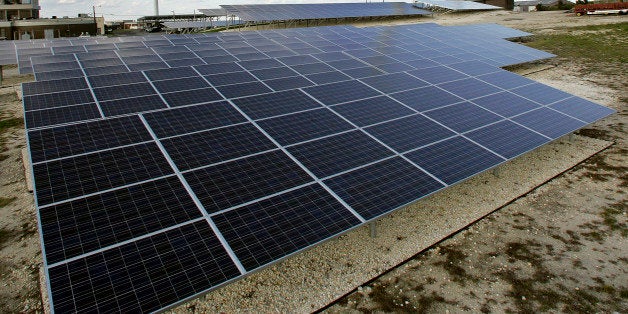
WASHINGTON -- California's ambitious greenhouse gas reduction goals may be eminently achievable using available technologies, a new study finds, although the virtual elimination of fossil fuel to generate electricity is required.
The widespread electrification of transportation and other sectors within 40 years is a key requirement to meet emission reduction targets, with residents plugging their electrical cars into decarbonized grids, according to the paper, published online Friday by the journal Science.
Electricity would largely replace petroleum usage, growing from 15 percent to 55 percent of end-use as petroleum would fall from 45 percent to 15 percent between 2010 and 2050, according to modeling. Reaching greenhouse gas reduction targets would also require the phaseout of all coal power plants at the end of their 30-year lifespans, leaving only CO2-producing power plants that use carbon capture sequestration, a yet unproven technology.
At the heart of the study is how a large-scale economy can meet the goals first set forth in an unprecedented clean air and renewable energy law, California's Global Warming Solutions Act of 2006 (AB 32), which requires the reduction of emissions to 1990 levels by the year 2020 and sets a target for an additional 80 percent reduction by 2050.
Soon after going into effect, those ambitious standards came under attack from the oil and gas industry.
In 2010 California's Proposition 23 threatened to suspend the state's landmark global warming legislation, with Texas oil companies and midwestern special interest groups donating millions in support of the ballot measure. In September of 2010 the company owned by oil billionaires David and Charles Koch, who have sponsored a whole host of efforts aimed at denying climate change science, joined the effort to suspend California's greenhouse gas reduction law, making a million-dollar contribution in support of Prop 23.
Things have looked up for environmentalists in the Golden State since then.
Prop 23 went down to overwhelming defeat last fall, with more than 60 percent of Californians voting against it. Now this peer-reviewed analysis shows meeting global warming targets would not require huge behavioral changes, like a mass conversion to veganism. Rather, goals are achievable even in the face of substantial population growth. (The analysis assumes a growth of 46 percent, from 38.8 million California residents in 2010 to 56.6 million in 2050.)
Jim Williams, the lead author on the paper, called meeting emissions targets "daunting, but not impossible."
"To reach this goal, energy efficiency comes first, followed by decarbonization of electricity generation, followed by the electrification of transportation and other sectors," says Williams, who serves as chief scientist at San Francisco-based energy consulting firm Energy and Environmental Economics (E3), in a statement.
To meet electricity demands between 2010 and 2050, however, non-carbon producing energy sources equivalent to the output of 1.5 to 2 nuclear power plants would have to be built each year, offsetting the loss of gasoline, coal and natural gas, according to modeling. Construction of nuclear power plants seems unlikely in part because California law mandates no nuclear power plant may be built until a safe disposal site for high-level nuclear waste has been approved. No existing repository has been identified, as plans for a nuclear waste site at Yucca Mountain were scrapped in 2010.
Of course, the modeling study, which estimated California could meet 75 percent of all energy needs through renewable energy resources, isn't "one size fits all." It was prescribed for a state with abundant solar and wind resources -- renewables that in central and nothern states would not be so readily available. In southern states like Arizona with copious sun, however, the opportunities for solar may be even greater.
For perspective: In 2009, 20.8 percent of California energy came from renewable sources. By 2050 there would be no energy from coal or natural gas sources without carbon capture.
"This study is meant to guide decisions about how to invest in our future. Assuming plausible technological advances, we find that it's possible for California to achieve deep greenhouse gas reductions by 2050," said Margaret Torn, the corresponding author of the paper and a staff scientist in the U.S. Department of Energy's Lawrence Berkeley National Laboratory.
Relying on solar and wind would require significant investment in energy storage, like improving battery power technology or transferring water uphill with excess energy then using it to generate power when it runs downhill through a turbine at a later time.
It would also come at a net cost of roughly $65 billion per year by 2050 -- the equivalent of 1.3 percent of gross state product, if the price of oil continues to rise as expected. Such costs, authors have noted, would be somewhat offset by reduced health care costs due to cleaner air as well as green jobs.
"It isn't a matter of technology alone," said Williams in a statement. "R&D, investment, infrastructure planning, incentives for businesses, even behavior changes, all have to work in tandem. This requires policy, and society needs to be behind it."